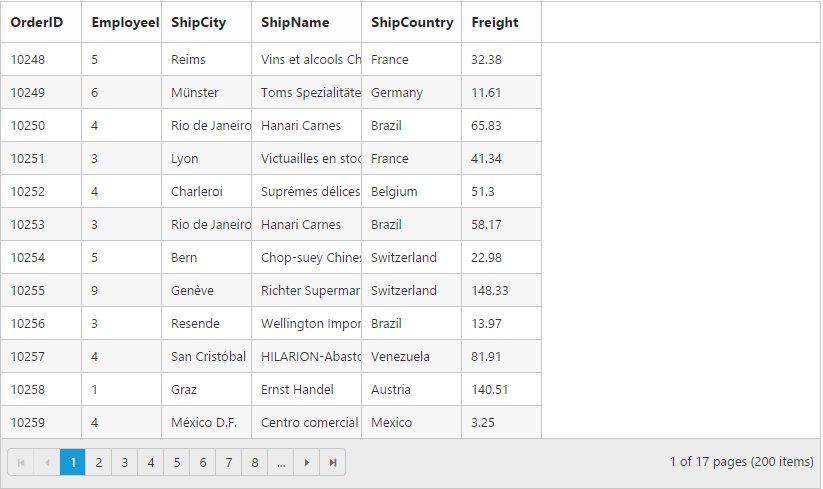Columns in ASP.NET Core Grid
12 Jun 202324 minutes to read
The column definitions are used as the DataSource schema in the Grid and it plays vital role in rendering column values in required format and sorting, filtering, editing based on its type. The field property of the columns is necessary to map the datasource values in grid columns.
NOTE
- The column with
fieldwhich are not in the datasource, then the column values will be displayed as empty.- If the
fieldname contains “dot” then it is considered as complex binding.
Auto generation
The columns are automatically generated when columns declaration is empty or undefined while initializing the grid. Also, all the columns which are in dataSource are bound as a grid e-columns.
<ej-grid id="FlatGrid" allow-paging="true" datasource="ViewBag.DataSource">
</ej-grid>namespace MVCSampleBrowser.Controllers
{
public class GridController : Controller
{
public IActionResult GridFeatures()
{
var DataSource = new NorthwindDataContext().OrdersViews.ToList();
ViewBag.DataSource = DataSource;
return View();
}
}
}The following output is displayed as a result of the previous code example.
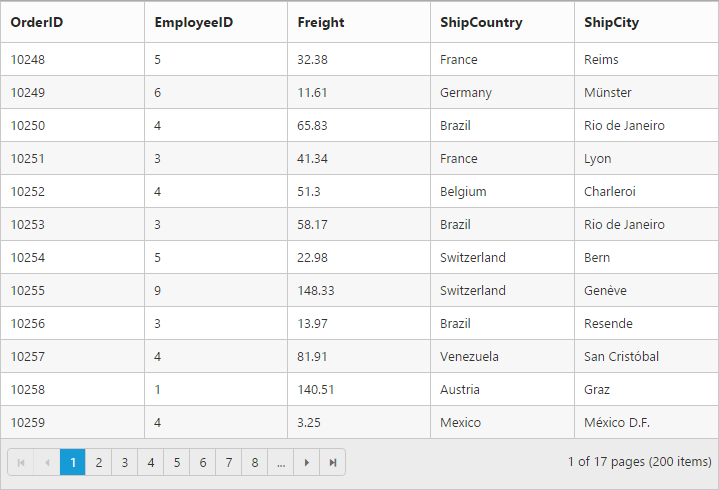
How to set the is-primary-key for auto generated columns when editing is enabled:
Using the data-bound event, you can set is-primary-key value as true by two ways. The following code example demonstrates the previous behavior.
- If primary key “column index” is known then refer to the following code example.
<ej-grid id="FlatGrid" allow-paging="true" data-bound="dataBound" datasource="ViewBag.DataSource">
<e-edit-settings allow-editing="true"></e-edit-settings>
</ej-grid>
<script type="text/javascript">
function dataBound(args) {
var column = args.model.columns[0];
//(or)
var column = this.getColumnByIndex(0);
column.isPrimaryKey = true;
//Here columns method used to update the particular column
this.columns(column, "update");
}
</script>namespace MVCSampleBrowser.Controllers
{
public class GridController : Controller
{
public IActionResult GridFeatures()
{
var DataSource = new NorthwindDataContext().OrdersViews.ToList();
ViewBag.DataSource = DataSource;
return View();
}
}
}- If primary key “column field name” is known then refer to the following code example.
<ej-grid id="FlatGrid" allow-paging="true" data-bound="dataBound" datasource="ViewBag.DataSource">
<e-edit-settings allow-editing="true"></e-edit-settings>
</ej-grid>
<script type="text/javascript">
function dataBound(args) {
var column = this.getColumnByField("OrderID");
column.isPrimaryKey = true;
//Here columns method used to update the particular column
this.columns(column, "update");
}
</script>namespace MVCSampleBrowser.Controllers
{
public class GridController : Controller
{
public IActionResult GridFeatures()
{
var DataSource = new NorthwindDataContext().OrdersViews.ToList();
ViewBag.DataSource = DataSource;
return View();
}
}
}Headers
Header text
It represents the title for particular column. To enable header text, set header-text property of e-columns. The following code example describes the previous behavior.
NOTE
If
header-textis not defined then thefieldname is considered as header text for that particular column. Iffieldname andheader-textalso not defined then the column is rendered with “empty” header text.
The following code example describes the previous behavior.
<ej-grid id="FlatGrid" allow-paging="true" datasource="ViewBag.DataSource">
<e-columns>
<e-column field="OrderID" header-text="Order ID"></e-column>
<e-column field="EmployeeID" header-text="Emp ID"></e-column>
<e-column field="Freight" header-text="Freight"></e-column>
<e-column field="ShipCountry" header-text="Country"></e-column>
<e-column field="ShipCity" header-text="City"></e-column>
</e-columns>
</ej-grid>namespace MVCSampleBrowser.Controllers
{
public class GridController : Controller
{
public IActionResult GridFeatures()
{
var DataSource = new NorthwindDataContext().OrdersViews.ToList();
ViewBag.DataSource = DataSource;
return View();
}
}
}The following output is displayed as a result of the previous code example.
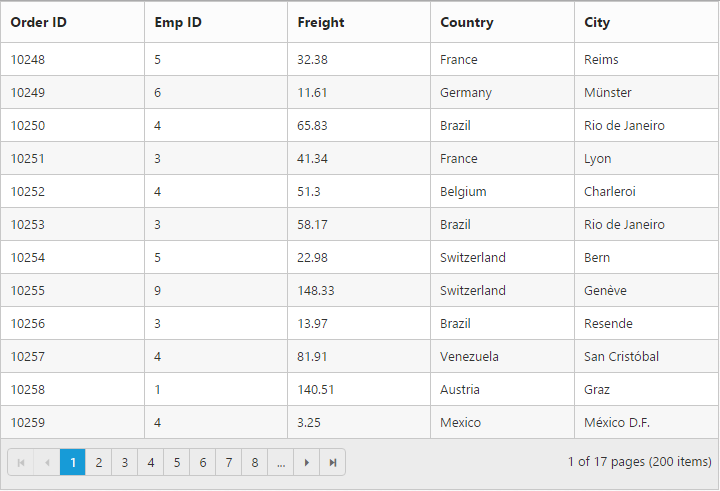
Header text alignment
Align the header text of column header using the header-text-align property of the e-columns. There are four possible ways to align header text, they are as follows.
- Right
- Left
- Center
- Justify
NOTE
For
HeaderTextAlignproperty you can assignenumvalue (TextAlign.Right).
The following code example describes the previous behavior.
<ej-grid id="FlatGrid" allow-paging="true" datasource="ViewBag.DataSource">
<e-columns>
<e-column field="OrderID" header-text="Order ID" ></e-column>
<e-column field="EmployeeID" header-text="Emp ID" header-text-align="Right"></e-column>
<e-column field="Freight" header-text="Freight"></e-column>
<e-column field="ShipCountry" header-text="Country" header-text-align="Center"></e-column>
<e-column field="ShipCity" header-text="City" header-text-align="Right" ></e-column>
</e-columns>
</ej-grid>namespace MVCSampleBrowser.Controllers
{
public class GridController : Controller
{
public IActionResult GridFeatures()
{
var DataSource = new NorthwindDataContext().OrdersViews.ToList();
ViewBag.DataSource = DataSource;
return View();
}
}
}The following output is displayed as a result of the previous code example.
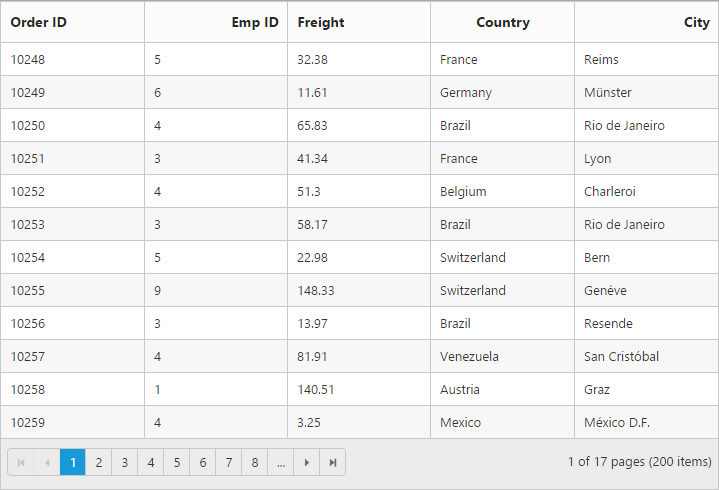
Header template
The template design that applies on for the column header. To render template, header-template-id property of e-columns.
The JsRender syntax can be used in the template. For more information about JsRender syntax, please refer the link.
NOTE
It’s a standard way to enclose the
templatewithin thescripttag withtypeastext/x-jsrender.
The following code example describes the previous behavior.
<ej-grid id="FlatGrid" allow-paging="true" datasource="ViewBag.DataSource">
<e-columns>
<e-column field="OrderID" header-text="Order ID" ></e-column>
<e-column field="EmployeeID" header-template-id="#empTemplate"></e-column>
<e-column field="Freight" header-text="Freight"></e-column>
<e-column field="ShipCountry" header-text="Country"></e-column>
<e-column field="ShipCity" header-text="City"></e-column>
</e-columns>
</ej-grid>namespace MVCSampleBrowser.Controllers
{
public class GridController : Controller
{
public IActionResult GridFeatures()
{
var DataSource = new NorthwindDataContext().OrdersViews.ToList();
ViewBag.DataSource = DataSource;
return View();
}
}
}<script id="empTemplate" type="text/x-jsrender">
Emp ID
<span class="e-userlogin e-icon employee"></span>
</script>Text alignment
The content and header text of a particular column can be aligned using the text-align property. There are four possible ways to align content and header text of column, they are as follows.
- Right
- Left
- Center
- Justify
NOTE
- For the
text-alignproperty,enumvalue (TextAlign.Right) can be assigned.- The
text-alignproperty will affect both content and header text of the grid.
The following code example describes the previous behavior.
<ej-grid id="FlatGrid" allow-paging="true" datasource="ViewBag.DataSource">
<e-columns>
<e-column field="OrderID" text-align="Right"></e-column>
<e-column field="EmployeeID" text-align="Right"></e-column>
<e-column field="Freight"text-align="Right"></e-column>
<e-column field="ShipCountry" text-align="Center"></e-column>
<e-column field="ShipCity"text-align="Justify"></e-column>
</e-columns>
</ej-grid>namespace MVCSampleBrowser.Controllers
{
public class GridController : Controller
{
public IActionResult GridFeatures()
{
var DataSource = new NorthwindDataContext().OrdersViews.ToList();
ViewBag.DataSource = DataSource;
return View();
}
}
}The following output is displayed as a result of the previous code example.

Format
Format is the process of customizing the particular column data with specified jQuery recognized globalize formats, such as currency, numeric, decimal, percentage or dates. To specify the globalize format, by using Format property of e-columns.
The format value should be wrapped within “{0:” and “}”. (For ex: “{0:C3}”). The data format strings available for the Date and Number types.
The following code example describes the previous behavior.
<ej-grid id="FlatGrid" allow-paging="true" datasource="ViewBag.DataSource">
<e-columns>
<e-column field="OrderID"></e-column>
<e-column field="EmployeeID"></e-column>
<e-column field="Freight" format="{0:C2}"></e-column>
<e-column field="OrderDate" format="{0:dd/MM/yyyy}"></e-column>
<e-column field="ShipCity"></e-column>
</e-columns>
</ej-grid>namespace MVCSampleBrowser.Controllers
{
public class GridController : Controller
{
public IActionResult GridFeatures()
{
var DataSource = new NorthwindDataContext().OrdersViews.ToList();
ViewBag.DataSource = DataSource;
return View();
}
}
}The following output is displayed as a result of the previous code example.
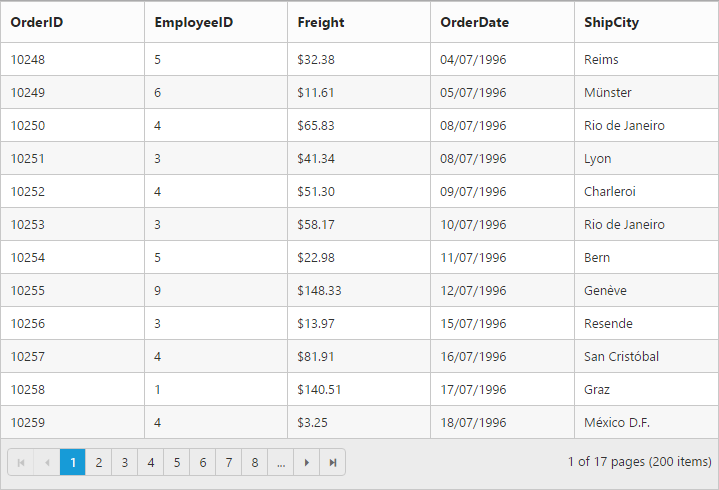
Width
The width for a particular column can be specified by setting width property of e-columns as in pixel (ex: 100) or in percentage (ex: 40%).
The following code example describes the previous behavior.
<ej-grid id="FlatGrid" allow-paging="true" datasource="ViewBag.DataSource">
<e-columns>
<e-column field="OrderID" width=@("10%")></e-column>
<e-column field="EmployeeID" width=@("15%")></e-column>
<e-column field="Freight" width="100"></e-column>
<e-column field="ShipCity" width="150"></e-column>
<e-column field="ShipCountry" width="100"></e-column>
</e-columns>
</ej-grid>namespace MVCSampleBrowser.Controllers
{
public class GridController : Controller
{
public IActionResult GridFeatures()
{
var DataSource = new NorthwindDataContext().OrdersViews.ToList();
ViewBag.DataSource = DataSource;
return View();
}
}
}The following output is displayed as a result of the previous code example.
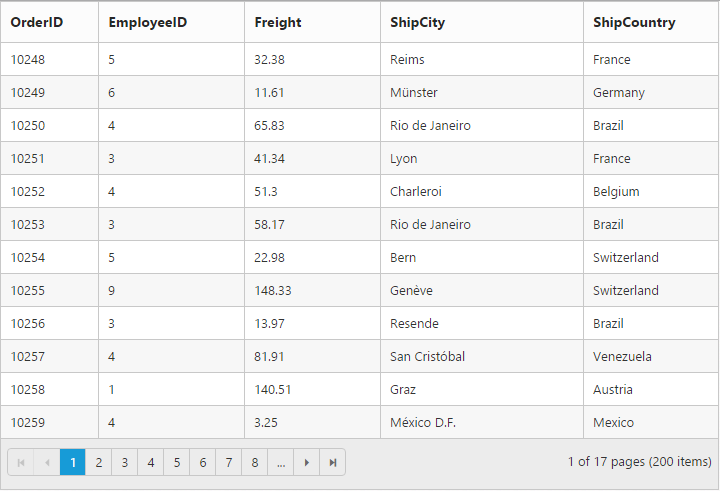
Resizing
The allow-resizing property enables the grid to set the width to columns based on resizing the grid column manually.
Resizing modes
resizeMode property of e-resize-settings is used to change the resizing modes. It indicates whether to define mode of resizing.
| Name | Description |
|---|---|
| Normal | New column size will be adjusted by all other Columns |
| NextColumn | New column Size will be adjusted using next column. |
| Control | New column Size will be adjusted using entire control |
The following code example describes the above behavior.
<ej-grid id="Grid" datasource=ViewBag.parent allow-resizing="true">
<e-resize-settings resize-mode="NextColumn"></e-resize-settings>
<e-columns>
<e-column field="ShipCity" header-text="Ship City" text-align="Right" width="80"></e-column>
<e-column field="ShipPostalCode" header-text="Ship Postal Code" width="40"></e-column>
<e-column field="ShipName" header-text="Ship Name" width="40"></e-column>
<e-column field="ShipAddress" header-text="Ship Address" width="100"></e-column>
</e-columns>
</ej-grid>namespace MVCSampleBrowser.Controllers
{
public partial class GridController : Controller
{
List<Orders> order = new List<Orders>();
public ActionResult GridFeatures()
{
ViewBag.datasource = Orders;
return View();
}
}
}Resize to fit
The allow-resize-to-fit property enable the grid to set width to columns based on maximum width of the particular column’s content to facilitate full visibility of data in all the grid rows and this automatic behavior is applicable only for the columns which does not have width specified.
On columns where “width is defined”, double-click on the particular column header’s resizer symbol to resize the column to show the whole text. For example, refer to the “ShipCity” column in the below code snippet and output screenshot.
The following code example describes the previous behavior.
<ej-grid id="FlatGrid" allow-paging="true" allow-resize-to-fit="true" datasource="ViewBag.DataSource">
<e-columns>
<e-column field="OrderID" width="100"></e-column>
<e-column field="EmployeeID"></e-column>
<e-column field="Freight" width="75"></e-column>
<e-column field="ShipCity" width="50"></e-column>
<e-column field="ShipAddress"></e-column>
</e-columns>
</ej-grid>namespace MVCSampleBrowser.Controllers
{
public class GridController : Controller
{
public IActionResult GridFeatures()
{
var DataSource = new NorthwindDataContext().OrdersViews.ToList();
ViewBag.DataSource = DataSource;
return View();
}
}
}The following output is displayed as a result of the previous code example.
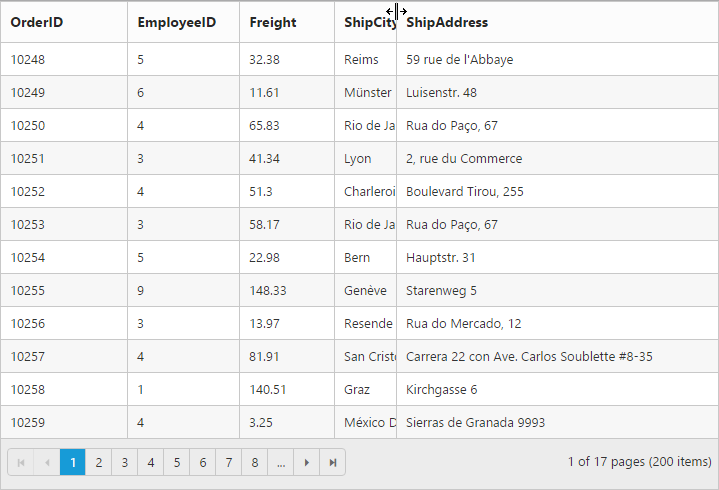
Reorder
Reordering can be done by drag and drop of the particular column header from one index to another index within the grid. Reordering can be enabled by setting the allow-reordering property as true.
The following code example describes the previous behavior.
<ej-grid id="FlatGrid" allow-paging="true" allow-reordering="true" datasource="ViewBag.DataSource">
<e-columns>
<e-column field="OrderID"></e-column>
<e-column field="EmployeeID"></e-column>
<e-column field="ShipCity"></e-column>
<e-column field="ShipCountry"></e-column>
<e-column field="Freight"></e-column>
</e-columns>
</ej-grid>namespace MVCSampleBrowser.Controllers
{
public class GridController : Controller
{
public IActionResult GridFeatures()
{
var DataSource = new NorthwindDataContext().OrdersViews.ToList();
ViewBag.DataSource = DataSource;
return View();
}
}
}The following output is displayed as a result of the previous code example.
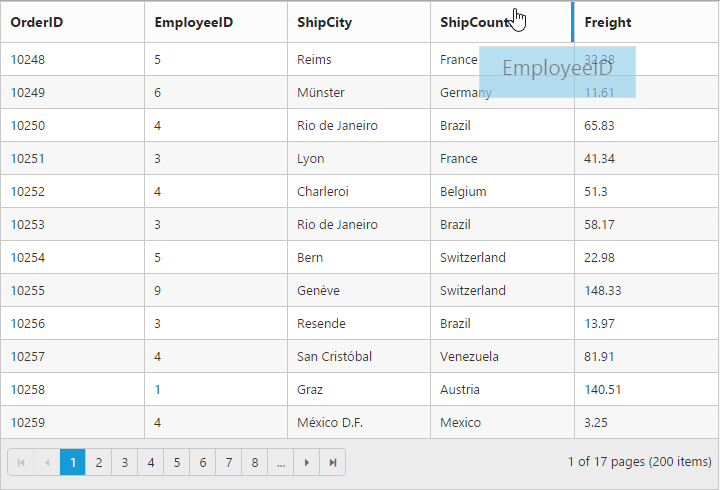
Visibility
The particular column in the grid view can be hid by setting the visible property of it as false.
The following code example describes the previous behavior.
<ej-grid id="FlatGrid" allow-paging="true" allow-reordering="true" datasource="ViewBag.DataSource">
<e-columns>
<e-column field="EmployeeID"></e-column>
<e-column field="OrderID" visible="false"></e-column>
<e-column field="Freight"></e-column>
<e-column field="ShipCity"></e-column>
<e-column field="ShipCountry"></e-column>
</e-columns>
</ej-grid>namespace MVCSampleBrowser.Controllers
{
public class GridController : Controller
{
public IActionResult GridFeatures()
{
var DataSource = new NorthwindDataContext().OrdersViews.ToList();
ViewBag.DataSource = DataSource;
return View();
}
}
}The following output is displayed as a result of the previous code example.

Unbound Column
You can define the unbound columns in grid by not defining field property for that particular. Value for this columns can be populated either manually using query-cell-info event or by using column-template.
NOTE
Editing, grouping, filtering, sorting, summary and searching support are not available for unbound columns.
The following code example describes the previous behavior.
<ej-grid id="FlatGrid" allow-paging="true" datasource="ViewBag.DataSource">
<e-edit-settings allow-deleting="true"/>
<e-columns>
<e-column field="OrderID" is-primary-key="true"></e-column>
<e-column field="EmployeeID"></e-column>
<e-column field="CustomerID"></e-column>
<e-column field="Freight"></e-column>
<e-column header-text="" format="<a onclick = click(this) href=#>Delete</a>"></e-column>
</e-columns>
</ej-grid>namespace MVCSampleBrowser.Controllers
{
public class GridController : Controller
{
public IActionResult GridFeatures()
{
var DataSource = new NorthwindDataContext().OrdersViews.ToList();
ViewBag.DataSource = DataSource;
return View();
}
}
}<script type="text/javascript">
function click(e) {
var obj = $("#FlatGrid").data("ejGrid");
obj.deleteRecord("OrderID", obj.getSelectedRecords()[0]);
}
</script>The following output is displayed as a result of the previous code example.
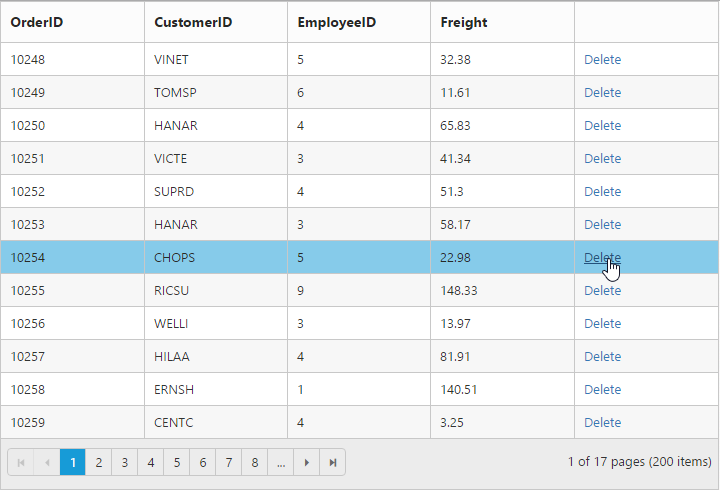
Controlling grid actions
You can control the grid actions of a particular column by setting allow-sorting,allow-grouping, allow-filtering and allow-editing properties of it as false.
The following code example describes the previous behavior.
<ej-grid id="FlatGrid" allow-paging="true" allow-resizing="true" allow-sorting="true" allow-grouping="true" allow-filtering="true" datasource="ViewBag.DataSource">
<e-edit-settings allow-editing="true"/>
<e-columns>
<e-column field="OrderID" is-primary-key="true"></e-column>
<e-column field="EmployeeID" allow-editing="false" allow-resizing="false" allow-sorting="false" allow-grouping="false"></e-column>
<e-column field="Freight"></e-column>
<e-column field="ShipCity"></e-column>
<e-column field="ShipCountry"></e-column>
</e-columns>
</ej-grid>namespace MVCSampleBrowser.Controllers
{
public class GridController : Controller
{
public IActionResult GridFeatures()
{
var DataSource = new NorthwindDataContext().OrdersViews.ToList();
ViewBag.DataSource = DataSource;
return View();
}
}
}Read only
To make a column as “read-only” then set the allow-editing property of e-columns as false.
The following code example describes the previous behavior.
<ej-grid id="FlatGrid" allow-paging="true" datasource="ViewBag.DataSource">
<e-edit-settings allow-editing="true"/>
<e-columns>
<e-column field="OrderID" is-primary-key="true"></e-column>
<e-column field="EmployeeID" allow-editing="false"></e-column>
<e-column field="Freight"></e-column>
<e-column field="ShipCity"></e-column>
<e-column field="ShipCountry"></e-column>
</e-columns>
</ej-grid>namespace MVCSampleBrowser.Controllers
{
public class GridController : Controller
{
public IActionResult GridFeatures()
{
var DataSource = new NorthwindDataContext().OrdersViews.ToList();
ViewBag.DataSource = DataSource;
return View();
}
}
}The following output is displayed as a result of the previous code example.
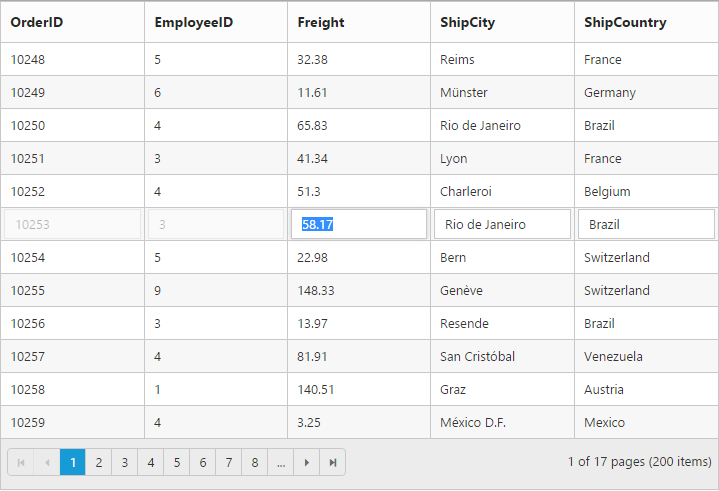
Command column
Default action buttons
Using Command column, you can add CRUD action buttons as one of the grid column, through type property of e-column-command. The type property supports the below default buttons.
- Edit
- Save
- Delete
- Cancel
Through the e-button-options property of e-column-commands, you can specify all the button options which are supported by Essential Studio ASP.NET MVC button control.
The following code example describes the previous behavior.
<ej-grid id="FlatGrid" allow-paging="true" datasource="ViewBag.DataSource">
<e-edit-settings allow-editing="true" allow-deleting="true" allow-adding="true"/>
<e-columns>
<e-column field="OrderID" is-primary-key="true"></e-column>
<e-column field="EmployeeID"></e-column>
<e-column field="Freight" edit-type="NumericEdit"></e-column>
<e-column field="ShipCountry"></e-column>
<e-column header-Text="Manage Records">
<e-column-commands>
<e-column-command type="edit">
<e-button-options content-type="TextOnly" text="Edit"></e-button-options>
</e-column-command>
<e-column-command type="delete">
<e-button-options content-type="TextOnly" text="Delete"></e-button-options>
</e-column-command>
<e-column-command type="save">
<e-button-options content-type="TextOnly" text="Save"></e-button-options>
</e-column-command>
<e-column-command type="cancel">
<e-button-options content-type="TextOnly" text="Cancel"></e-button-options>
</e-column-command>
</e-column-commands>
</e-column>
</e-columns>
</ej-grid>namespace MVCSampleBrowser.Controllers
{
public class GridController : Controller
{
public IActionResult GridFeatures()
{
var DataSource = new NorthwindDataContext().OrdersViews.ToList();
ViewBag.DataSource = DataSource;
return View();
}
}
}The following output is displayed as a result of the previous code example.

Custom buttons
You can add custom button in the command column by specifying the type property of e-column-commands as empty or any other string instead of enum values.
NOTE
- For
typeproperty, you can assignstringvalue (edit).- In command column you can add only buttons.
The following code example describes the previous behavior.
@(Html.EJ().Grid<Object>("FlatGrid")
.Datasource((IEnumerable<object>)ViewBag.DataSource)
.AllowPaging()
.Columns(col =>
{
col.Field("EmployeeID").Add();
col.HeaderText("Employee Details").Commands(command =>
{
command.Type("detail")
.ButtonOptions(new Syncfusion.JavaScript.Models.ButtonProperties()
{
Text = "Details",
Width = "100px",
Click = "onClick"
}).Add();
})
.TextAlign(TextAlign.Center)
.Width(150)
.Add();
})
)namespace MVCSampleBrowser.Controllers
{
public class GridController : Controller
{
public ActionResult GridFeatures()
{
var DataSource = new NorthwindDataContext().OrdersView.ToList();
ViewBag.DataSource = DataSource;
return View();
}
}
}<ej-grid id="FlatGrid" allow-paging="true" datasource="ViewBag.DataSource">
<e-columns>
<e-column field="EmployeeID"></e-column>
<e-column header-Text="Employee Details">
<e-column-commands>
<e-column-command type="details">
<e-button-options content-type="TextOnly" text="Edit"></e-button-options>
</e-column-command>
</e-column-commands>
</e-column>
</e-columns>
</ej-grid>namespace MVCSampleBrowser.Controllers
{
public class GridController : Controller
{
public IActionResult GridFeatures()
{
var DataSource = new NorthwindDataContext().OrdersViews.ToList();
ViewBag.DataSource = DataSource;
return View();
}
}
}<script type="text/javascript">
function onClick(args) {
var grid = $("#FlatGrid").ejGrid("instance");
var index = this.element.closest("tr").index();
var record = grid.getCurrentViewData()[index];
alert("Record Details: " + JSON.stringify(record));
}
</script>The following output is displayed as a result of the previous code example.

Column chooser
Column chooser contains all the columns which are defined in the e-columns property, using this you can control the visibility of columns in grid. You can prevent to show the particular column in column chooser by setting show-in-column-chooser property of e-columns as false. It can be shown in the right corner of grid. To enable column chooser, show-column-chooser property as true.
The following code example describes the previous behavior.
<ej-grid id="FlatGrid" allow-paging="true" show-column-chooser="true" datasource="ViewBag.DataSource">
<e-edit-settings allow-editing="true"/>
<e-columns>
<e-column field="OrderID" is-primary-key="true"></e-column>
<e-column field="EmployeeID" show-in-column-chooser="false"></e-column>
<e-column field="Freight"></e-column>
<e-column field="ShipCity"></e-column>
<e-column field="ShipCountry"></e-column>
</e-columns>
</ej-grid>namespace MVCSampleBrowser.Controllers
{
public class GridController : Controller
{
public IActionResult GridFeatures()
{
var DataSource = new NorthwindDataContext().OrdersViews.ToList();
ViewBag.DataSource = DataSource;
return View();
}
}
}The following output is displayed as a result of the previous code example.
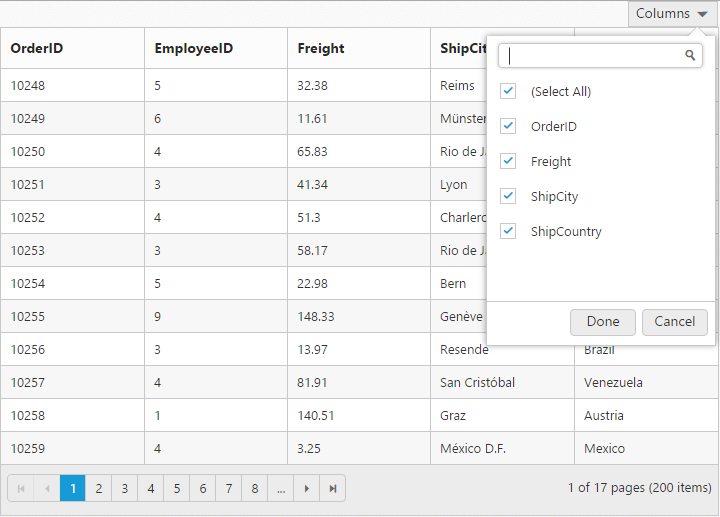
Foreign key column
Lookup data source can be bound to the data-source property of e-columns. Data field and text can be set using foreign-key-field and foreign-key-value property of e-columns.
In the data-source property, we can bound local and remote data.
IMPORTANT
For foreign key column the sorting and grouping is based on
foreign-key-fieldinstead offoreign-key-value.You can refer Foreign Key Adaptor to sort and group the foreign key column based onForeignKeyValue.
NOTE
In remote data, server should be configured to perform select and filter operations since the grid will try to fetch required columns using select operation and required data using filter operation.
NOTE
To render a Hierarchy Grid with different
foreign-key-fieldin parent and child table, clickhere.
The following code example describes the previous behavior.
<ej-grid id="FlatGrid" allow-paging="true" datasource="@ViewBag.DataSource1">
<e-edit-settings allow-editing="true" allow-adding="true" allow-editing="true"/>
<e-columns>
<e-column field="OrderID" is-primary-key="true"></e-column>
<e-column field="EmployeeID" header-text="first Name" foreign-key-field="EmployeeID" foreign-key-value="FirstName" datasource="@ViewBag.DataSource2"></e-column>
<e-column field="CustomerID"></e-column>
<e-column field="Freight"></e-column>
<e-column field="ShipCity"></e-column>
</e-columns>
</ej-grid>namespace MVCSampleBrowser.Controllers
{
public class GridController : Controller
{
public ActionResult GridFeatures()
{
var DataSource1 = new NorthwindDataContext().OrdersViews.ToList();
ViewBag.DataSource1 = DataSource1;
var DataSource2 = new NorthwindDataContext().EmployeeViews.ToList();
ViewBag.DataSource2 = DataSource2;
return View();
}
}
}The following output is displayed as a result of the previous code example.
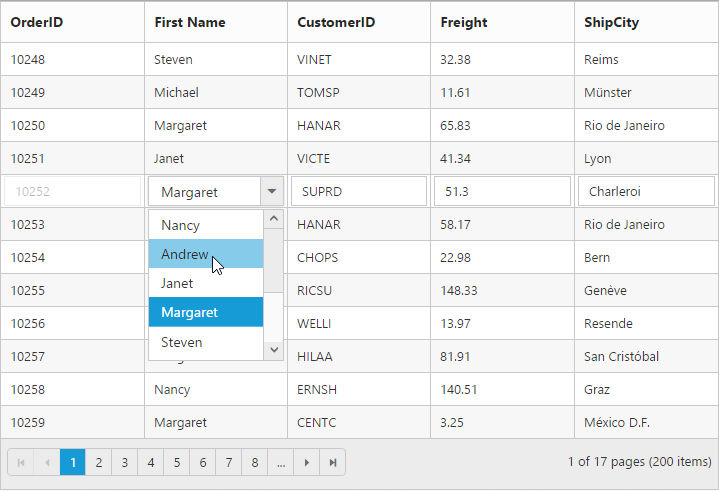
Customize column
You can customize the header and content of that particular column by css-class property of the column.
The following code example describes the previous behavior.
<ej-grid id="FlatGrid" allow-paging="true" datasource="ViewBag.DataSource">
<e-columns>
<e-column field="OrderID"></e-column>
<e-column field="CustomerID" css-class="customCss"></e-column>
<e-column field="EmployeeID"></e-column>
<e-column field="Freight"></e-column>
</e-columns>
</ej-grid>namespace MVCSampleBrowser.Controllers
{
public class GridController : Controller
{
public ActionResult GridFeatures()
{
var DataSource1 = new NorthwindDataContext().OrdersViews.ToList();
ViewBag.DataSource = DataSource1;
return View();
}
}
}.customCss.e-headercell {
background-color: #2382c3;
color: white;
font-family: 'Bell MT';
font-size: 20px;
}
.customCss.e-rowcell {
background-color: #ecedee;
font-family: 'Bell MT';
color: red;
font-size: 20px;
}The following output is displayed as a result of the previous code example.
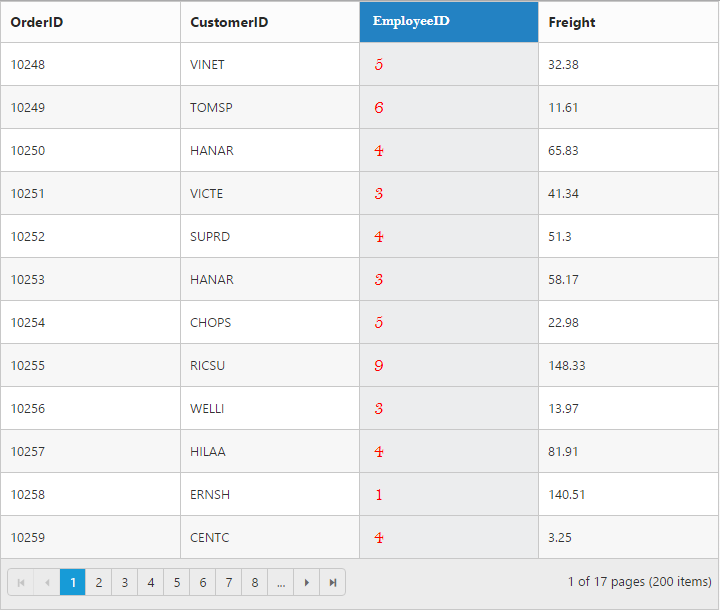
Type
Used to define the type of the particular column data. If the type property of e-columns is not specified then its type is automatically defined based on the first row data of that column.
NOTE
The
typeis needed for filtering feature when first row of the data isnullorempty.
The following code example describes the previous behavior.
<ej-grid id="FlatGrid" allow-paging="true" datasource="ViewBag.DataSource">
<e-columns>
<e-column field="OrderID"></e-column>
<e-column field="CustomerID" type="string"></e-column>
<e-column field="EmployeeID" type="number"></e-column>
<e-column field="Freight"></e-column>
<e-column field="ShipCountry"></e-column>
</e-columns>
</ej-grid>namespace MVCSampleBrowser.Controllers
{
public class GridController : Controller
{
public ActionResult GridFeatures()
{
var DataSource1 = new NorthwindDataContext().OrdersViews.ToList();
ViewBag.DataSource = DataSource1;
return View();
}
}
}The following output is displayed as a result of the previous code example.
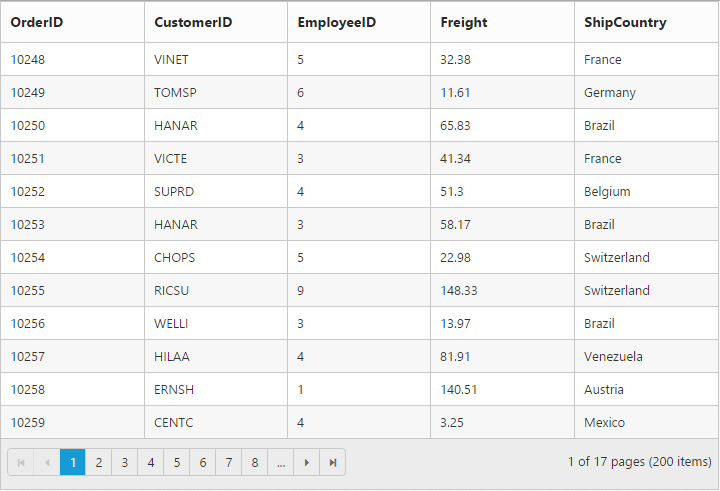
Column layout
You can set the grid’s columns layout based on either grid width or its columns width using column-layout property of it. There are two ways to set the column layout, they are as follows.
- Auto
- Fixed
<ej-grid id="FlatGrid" allow-paging="true" datasource="ViewBag.DataSource" column-layout="Fixed">
<e-columns>
<e-column field="OrderID" width="80"></e-column>
<e-column field="EmployeeID" width="80"></e-column>
<e-column field="ShipCity" width="90"></e-column>
<e-column field="ShipName" width="110"></e-column>
<e-column field="ShipCountry" width="100"></e-column>
<e-column field="Freight" width="80"></e-column>
</e-columns>
</ej-grid>namespace MVCSampleBrowser.Controllers
{
public class GridController : Controller
{
public ActionResult GridFeatures()
{
var DataSource1 = new NorthwindDataContext().OrdersViews.ToList();
ViewBag.DataSource = DataSource1;
return View();
}
}
}The following output is displayed as a result of the previous code example.
